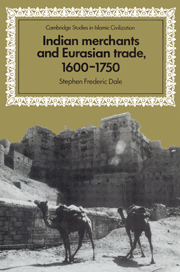Book contents
- Frontmatter
- Contents
- List of illustrations
- Preface
- Note on transliteration
- Abbreviations
- 1 An Indian world economy
- 2 India, Iran and Turan in 1600
- 3 The Indian diaspora in Iran and Turan
- 4 Indo-Russian commerce in the early modern era
- 5 The Indian diaspora in the Volga basin
- 6 Imperial collapse, mercantilism and the Mughul diaspora
- Appendix
- Bibliography
- Index
1 - An Indian world economy
Published online by Cambridge University Press: 22 September 2009
- Frontmatter
- Contents
- List of illustrations
- Preface
- Note on transliteration
- Abbreviations
- 1 An Indian world economy
- 2 India, Iran and Turan in 1600
- 3 The Indian diaspora in Iran and Turan
- 4 Indo-Russian commerce in the early modern era
- 5 The Indian diaspora in the Volga basin
- 6 Imperial collapse, mercantilism and the Mughul diaspora
- Appendix
- Bibliography
- Index
Summary
Have we not Indian carpets dark as wine,
Turbans and sashes, gowns and bows and veils,
And broideries of intricate design,
And printed hangings in enormous bales?
James Elroy Flecker: “The Golden Journey to Samarqand”In a discussion of the commerce and business classes of Safavid Iran (1501–1722), Mehdi Keyvani has remarked that the presence and proliferation of Indian “moneychangers” in several major Iranian cities during the later Safavid period is “an astonishing and unexplained episode of Iranian economic history.” Keyvani would have been justified in adding that the increased settlement of these Indians in Iran has also remained an unexplained aspect of Indian economic history in this period when Mughul emperors ruled the northern half of the South Asian subcontinent (1526–1739). If no more than a few Indians had been involved their presence might justifiably be dismissed as an intriguing anomaly that had no fundamental significance for the economic history of either Iran or India, but thousands and perhaps tens of thousands of Indian businessmen lived and worked in Iran in the seventeenth and early eighteenth century. Some of these men were moneychangers and/or moneylenders, but many of the same individuals also worked as retail and wholesale merchants, commodity brokers and financiers. Taken as a whole they constituted an influential but rarely noticed trade diaspora that also encompassed the Uzbek khanates of western Turkistan or Turan (c. 1500–1920). In the early seventeenth century the diaspora extended its mercantile activities to include the Russian Caspian port of Astrakhan, the Volga basin and, for a brief period, Moscow itself.
- Type
- Chapter
- Information
- Indian Merchants and Eurasian Trade, 1600–1750 , pp. 1 - 13Publisher: Cambridge University PressPrint publication year: 1994

